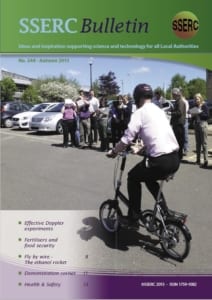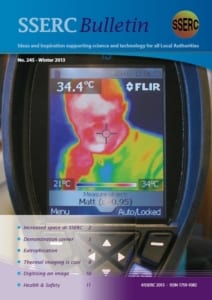Beyond the visible
Explorations with a simple, inexpensive digital microscope – images taken with the Veho VMS-001 200x USB digital microscope.
Doing it outdoors
Duncan MacLean, Senior Tutor at the Field Studies Council centre at Kindrogan, offers us his insight into why outdoor learning should be encouraged.
Demonstration corner
The elephant’s toothpaste – This is a fun, yet simple demonstration showing the exothermic catalytic breakdown of hydrogen peroxide.
Dopa oxidase, a perfect enzyme?
The advent of the Revised and CfE Highers in Biology and Human Biology, and Revised and CfE Advanced Higher in Biology [1-4] has prompted the Biology Team in SSERC to consider different enzyme systems for use in practical work and/or investigations.
Health & Safety
Eye dissection – using deer eyes
SSERC has recently received a number of enquiries about whether deer eyes can be used for dissection. Although not mentioned specifically in the Code of Practice Materials of Living Origin the guidance within the code is also relevant for use with deer eyes. Furthermore general advice on eye dissection can be found in the SSERC Bulletin articles Dissecting eyes – hints and tips and Dissecting bulls’ eyes.
Citric acid
When carrying out any quantitative work in chemistry, it is important to know the concentration of any solutions you use. Too great a concentration and some reactions will become dangerous, too low a concentration and some reactions will not work.
An eagle-eyed SSERC member has spotted that different containers of citric acid which her school has bought recently from the same supplier have different hazard symbols on them and is, understandably, a bit confused…….The precautions taken when handling a chemical should be determined by a risk assessment that uses the best available advice. We would suggest, not surprisingly perhaps, that the advice of SSERC trumps the ‘raw’ MSDS as ours is drawn up considering the sorts of uses and exposure encountered in schools.
Conductivity on the cheap
The conductivity of a solution is, not surprisingly, a measure of its ability to conduct electricity. The measurement of conductivity is a routine technique in many industrial and environmental applications as a fast, cheap and reliable way of measuring the ionic content of a solution. It is commonly used, for instance, as a method of assessing the effectiveness of water purification systems
Demonstration corner – The Silver Mirror
Just to show that chemistry is not all about whooshes and bangs, here is a quiet, gentle and beautiful demonstration that is really quite easy to do.
The Modern Science Teacher – new publication
SSERC’s latest publication The Modern Science Teacher is designed as an introductory support for new entrants to the science teaching profession.
A year in the life of SSERC
For the past few years SSERC has published a year planner which features our professional development courses for the coming 12 months. The most recent version has been printed and copies have been sent to schools throughout Scotland.
Logging in a wireless wonderland
For the past few years SSERC has published a year planner which features our professional development courses for the coming 12 months. The most recent version has been printed and copies have been sent to schools throughout Scotland.
Health & Safety
Risk assessment revisited
It has been some time since we published specific guidance about the process of risk assessment. Recently, we have noticed an upsurge in the number of enquiries about this, so we felt that it was a good time to address some of the frequently asked questions on the topic.
Effective Doppler experiments
In Bulletin 234, we published an article called Higher Pitched about using the freeware sound handling package Audacity to demonstrate the Doppler Effect. It is a measure of the rapidity of change in the world of ICT that only two years later, we have a new method that is so much better it makes our previous efforts look almost embarrassing.
Fertilisers and food security
‘Food security is the provision of sufficient amounts of safe, affordable, nutritious food that we need to underpin the health and wellbeing of all the human population across the globe’. [Prof. Julie Fitzpatrick (Scientific Director, Moredun Research Institute); 2012].
The world is facing a potential crisis in terms of food security. The challenge is to produce and supply enough safe and nutritious food in a sustainable way for a growing global population, which is projected to reach 9 billion by 2050.
Fly by wire – the ethanol rocket
The whoosh bottle, which we know and love here at SSERC, has become a standard feature in many chemistry classrooms. More recently, a variation has come to light which not only shows the energy changes of the different fuels but puts that energy to use. The version of this that appeared in a recent Education in Chemistry uses a length of guttering as a guide and fires a fizzy drinks bottle a satisfying distance. Having been looking at this for a while before the EiC article was published we decided to get down to some serious development and soon decided on an important modification.
Demonstration corner – The Belousov-Zhabotinsky reaction
Ever wondered what to do with that ‘redundant’ overhead projector stored away in one of your cupboards? Within the Chemistry Team at SSERC we have been looking at variants of the Belousov-Zhabotinsky reaction (an example of an oscillating chemical reaction)and the version presented here is probably best seen using an OHP and screen.
Health & Safety
Asperger’s Syndrome and the school science lab
We recently had an enquiry asking for advice on supporting a pupil with Asperger’s Syndrome. This is a form of autism, so we contacted the National Autistic Society for advice. We recommend visiting their website for details of the condition. The society could not have been more helpful and, with permission, we have reproduced their advice here. Whilst not every piece of advice will apply to an individual pupil with AS, we hope that it will help you with the special risk assessment necessary for pupils with this syndrome.
Health and safety on farm visits
A new industry code of practice Preventing or controlling ill health from animal contact at visitor attractions now replaces previous advice from Scottish Government, Health Protection Scotland and HSE.
Not socket science?
Have a look at the humble UK 3 pin electrical socket. It epitomises what health and safety people call an “engineered control measure”. The steps to protect people from harm are built into it – no need to rely on them putting on protective equipment, no need to rely on them behaving in a sensible manner. A UK socket does this by having the live and neutral terminals covered by a shutter that only opens when the slightly longer earth pin is inserted. This design, to BS 1363, has been around since 1947. Some recent designs need all three pins to be inserted simultaneously before the shutters will open ……
Increased space at SSERC
On September 17th, Dr Alasdair Allan MSP, Minister for Learning, Science and Scotland’s Languages opened a new building that greatly enhances our training space.
Demonstration corner – colour mixing
A number of methods are available to demonstrate mixing of different colours of light. One of the more intriguing methods that we have come across involves the use of so-called Lightsticks. In order to try this demonstration out we purchased a range of different coloured lightsticks (also known as glow sticks) from The Glow Company – www.TheGlowCompany.co.uk
Eutrophication – investigating the effects of fertilisers on the growth of an algal population
Warm summers in Scotland are usually met with great delight and this year has been no exception. However the hot, dry weather also contributed to some unwanted effects in many of our fresh water lochs and ponds. Cyanobacteria and fresh water algae, which live in these ecosystems, increased in number sometimes causing blue-green, or green blooms. In some cases these blooms took the form of unpleasant looking scum, or floating mats of algae.
Thermal imaging is cool
There are a good number of engaging activities that can be carried out with converted webcams to “see” into the infrared, but we always ended up telling teachers that they won’t pick up the radiation emitted by a person
because its frequency is too low for a silicon sensor. “For thermal imagery,” we’d say, “you need something costing thousands of pounds.”
Now, we’d tell them something slightly different. The FLIR i3, at £895 ex VAT, is not a device we’d dare describe as cheap when we know that some departments have around a tenth of this left from budgets after photocopying, but it is relatively inexpensive.
Digitising an image
A (possibly sad…) member of the SSERC Biology Team recently wanted to obtain the absorption spectrum of chlorophyll b in digital form. There are a number of ways by which this data set could be generated.
Health & Safety
Breaking bad bottles
We have had a few reports recently concerning the structural failure of plastic bottles. While this can often be a mere annoyance, the bottles in question have been ones containing concentrated acids.
Phenolphthalein
As the CLP/GHS system takes hold, a few changes in classification are coming to light. Most of these are minor alterations, usually due to shifting boundaries between, say, irritant and corrosive. A few, however, are more radical. Phenolphthalein is one such case.







